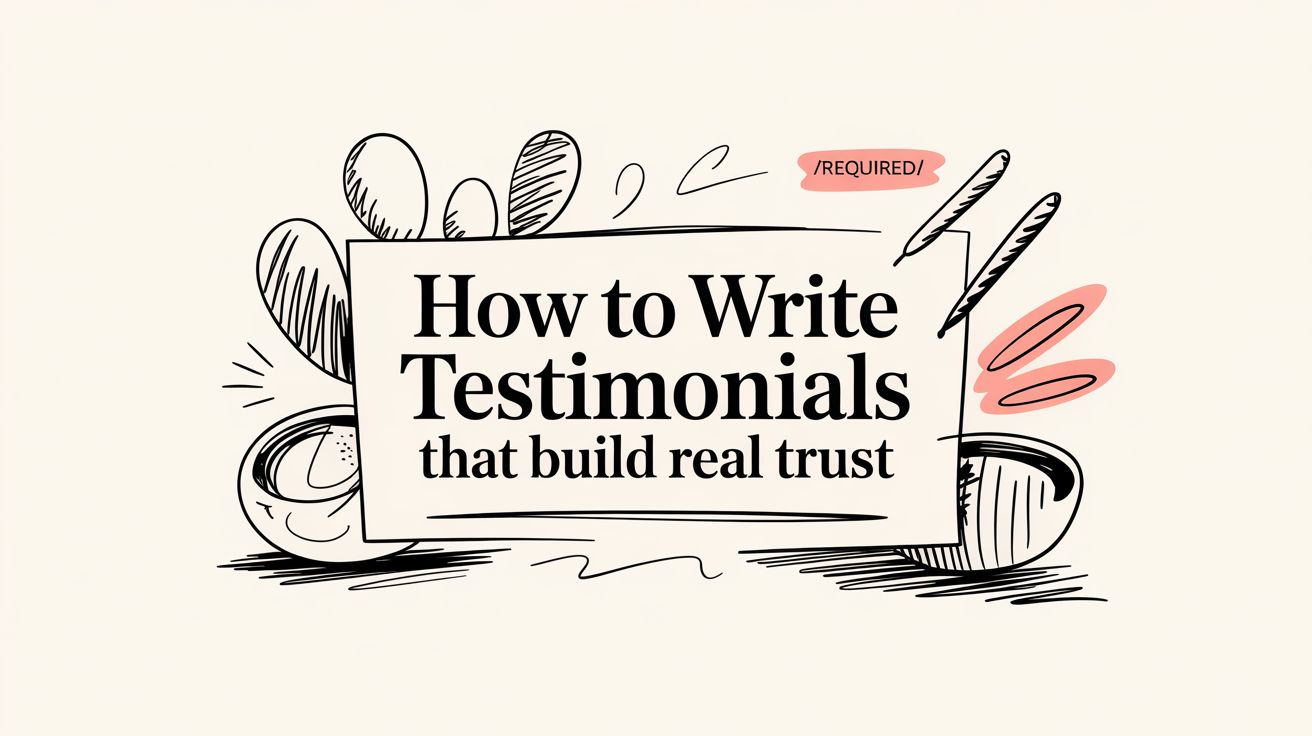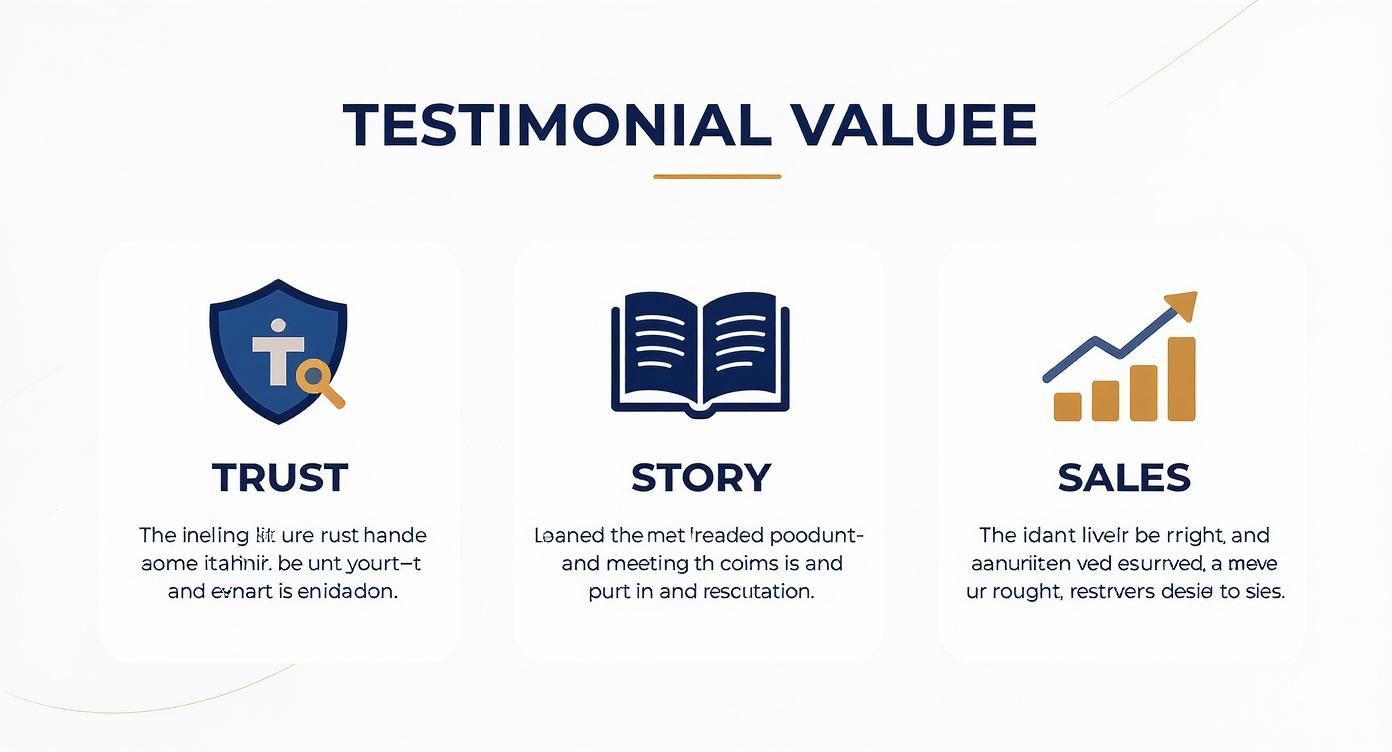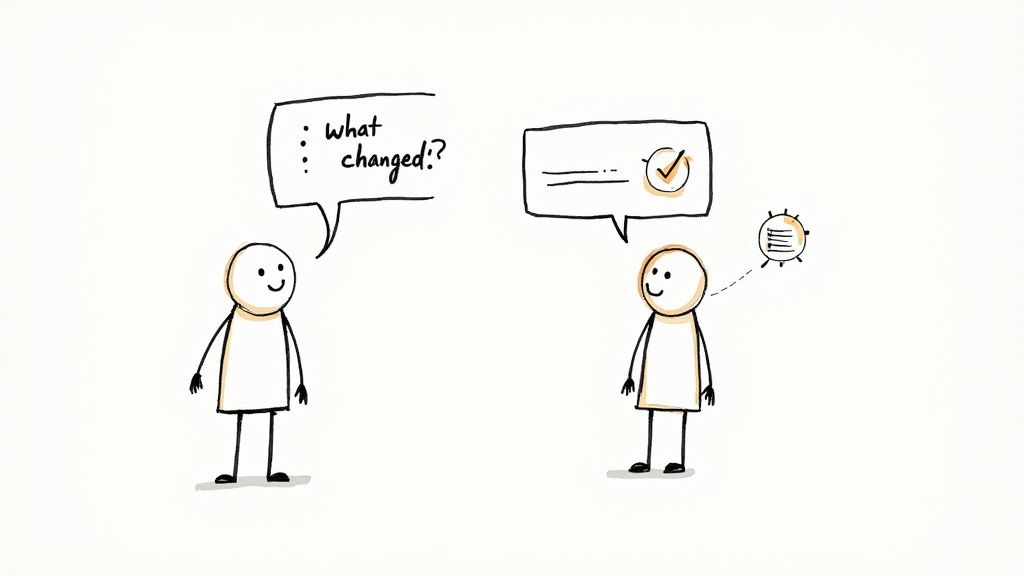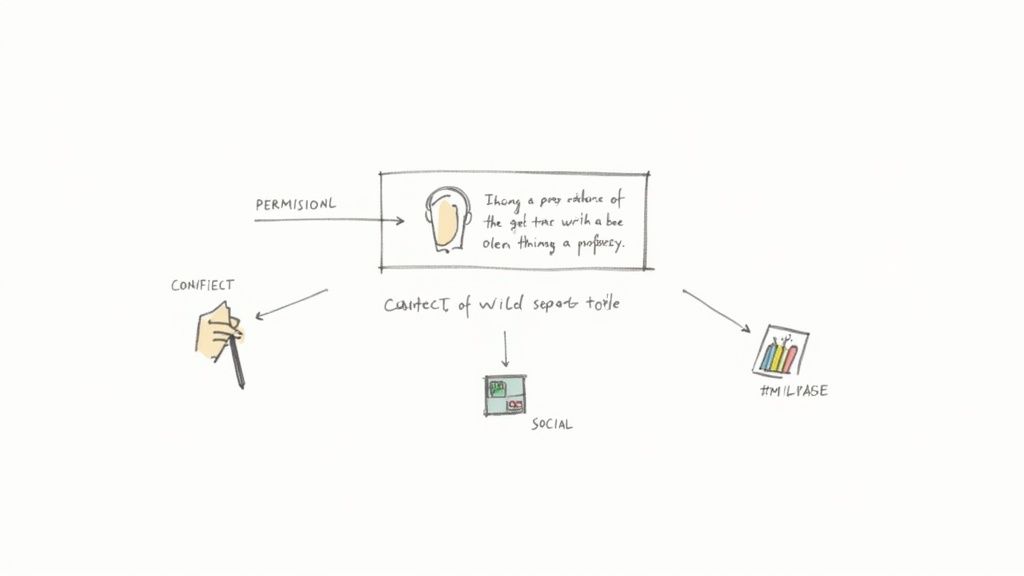How to Write Testimonials That Build Real Trust

To write a testimonial that truly hits home, you need to think like a storyteller. It's all about painting a picture: what was the problem before, how did the product create a solution, and what were the real, tangible results afterwards? This simple before-and-after journey is what builds trust and makes the feedback far more powerful than a generic thumbs-up.
Why Authentic Testimonials Are Non-Negotiable
Let's be real for a moment. Vague praise like "great service" just doesn't cut it anymore. Today, genuine customer stories are your single most valuable marketing asset because they provide social proof—that deep-seated human instinct to follow the actions of others. When a potential customer sees someone just like them winning with your product, it creates a level of trust that no slick ad campaign can ever hope to achieve.
This is especially true for UK shoppers. Consumer trust in online testimonials has skyrocketed, making them a deciding factor in whether someone clicks 'buy'. In fact, recent data shows that online reviews now have more sway over UK consumer behaviour than traditional advertising or even a brand's own claims. You can dive deeper into these trends in the UK Consumer Survey Report on Reputation.com.
The Power of a Believable Story
Think about the last time you read a review. Which one stuck with you? Was it the flat, forgettable one-liner, or the detailed story of a problem solved? A generic comment is easy to ignore, but a personal account is memorable and, most importantly, relatable.
A genuinely authentic story pulls its weight by:
- Tackling specific doubts: A great testimonial often answers the very questions and hesitations a new customer is wrestling with.
- Showcasing real results: It doesn't just say a product is "good"; it shows how it improved a situation with outcomes you can actually measure.
- Forging an emotional connection: Stories resonate with us on a human level, making your brand feel more approachable and trustworthy.
A testimonial isn’t just a review; it's a short story about a transformation. It’s proof that you don't just sell a product or service—you deliver a real solution to a real problem.
Learning how to guide your customers to share these kinds of impactful stories is one of the highest-return activities you can focus on. It essentially turns your happiest clients into your most effective sales team.
And with tools like Good Kudos, collecting these powerful narratives has never been easier, letting you build that all-important trust and drive growth without the hassle.
The Anatomy of a Powerful Testimonial
What's the real difference between a forgettable review and a testimonial that actually sells? It's the story. A powerful testimonial isn't just a pat on the back; it’s a short, persuasive narrative about a genuine transformation. That story is what helps potential customers see themselves in your past clients' successes, making it instantly relatable and far more believable.
The best testimonials almost always follow a simple, three-act structure: the before, the journey, and the after. This isn’t just a fancy storytelling trick—it's a proven framework for building trust and showing the tangible value you deliver. Learning how to guide your customers to tell their stories this way will completely change the impact of your social proof.
Start with the Problem
Every great story kicks off with a challenge. Before your customer found you, they were stuck, frustrated, or struggling with something specific. A strong testimonial leans into this. It doesn't gloss over the messy part; it highlights it, creating an immediate and powerful connection with prospects who are feeling that exact same pain right now.
Instead of a generic opener, a killer testimonial gets right to the heart of the problem. A weak one might say, "Their service was great." Yawn. A strong one starts with, "We were struggling to keep our project timelines organised, and deadlines were constantly slipping." See the difference? That honesty makes the solution feel so much more meaningful.
This infographic nails why this story-driven approach is so effective for building trust and, ultimately, driving sales.

As you can see, when you combine a relatable story with trustworthy elements, you create a direct path to better sales outcomes.
Detail the Journey and the Aftermath
Once you've set the scene with the problem, the story naturally pivots to the solution—your product or service. This is where the customer shares what it was actually like working with you. It’s their chance to explain how your solution was implemented and what the experience felt like from their perspective.
But the real knockout punch is the final part: the result. This is the 'after' state, where you show off a specific, measurable outcome. Vague results are the enemy here; they drain the power from the entire story.
A great testimonial replaces vague praise with specific proof. Instead of "it helped us grow," aim for "it helped us increase our client bookings by 30% in three months."
Quantifiable results like that offer concrete, undeniable evidence that your solution works. They turn a simple customer opinion into a compelling success story.
To help you put this into practice, here’s a breakdown of the key components that separate a weak testimonial from one that truly packs a punch.
Key Components of a Powerful Testimonial
| Component | Weak Example (Vague) | Strong Example (Specific & Benefit-Driven) |
|---|---|---|
| The Problem | "We needed a better system." | "Our team was wasting 10 hours a week on manual data entry, which was leading to costly errors." |
| The Solution | "The platform was really helpful." | "Their onboarding was seamless, and the software integrated with our existing tools in under an hour." |
| The Result | "Things are much better now." | "We've automated 90% of our data entry, saving the company over £2,000 a month and freeing up the team to focus on client work." |
By guiding your customers to share their 'before, journey, and after', you give them a simple framework for telling a story that sells for you. And if you're looking to capture these powerful narratives without all the back-and-forth, a platform like Good Kudos is designed to make the entire collection and showcasing process effortless.
How to Ask for Testimonials Without Being Awkward
We all know we need testimonials, but actually asking for them can feel a bit awkward. Pushy, even. The secret? Stop thinking of it as asking for a favour. Instead, you're giving a happy customer an opportunity to share their success story.
When you frame it that way and get the timing right, the whole process feels natural and easy for everyone.
The most important part is nailing the timing. Don’t let weeks or months go by after a project wraps up. You want to ask when the value you delivered is still fresh in their mind. That moment of ‘peak happiness’ is your golden window to capture their genuine excitement.

Pinpoint the Perfect Moment to Ask
Think about the specific points in your customer’s journey where they experience a clear win. These are the trigger points when you should reach out.
- Right after a project is finished: They’ve just seen the final result and are probably thrilled with how it all turned out.
- Following spontaneous positive feedback: If a client praises your work on a call or in an email, that’s your cue. Just reply with something like, "I'm so glad you feel that way! Would you be open to sharing that in a brief testimonial?"
- When they hit a tangible result: Did they tell you they just landed a new client or saved 10 hours a week because of your work? Ask them to share that specific win.
- After a great customer service interaction: A fantastic support experience builds a ton of loyalty and goodwill. It’s an ideal time to ask about their experience with your team.
Don't overthink it. The best time to ask is almost always right after they've expressed happiness. Capitalise on that positive momentum before it fades.
Guide Them with the Right Questions
Most people are happy to help, but they freeze when faced with a blank page. The biggest mistake you can make is asking a vague question like, “Could you write us a testimonial?” It puts all the work on their shoulders.
Instead, make it incredibly easy for them. Guide their story with specific, open-ended questions.
This approach doesn't just help your customer—it also ensures you get the kind of story-driven details that actually build trust. You’ll go from a generic “they were great to work with” to a compelling narrative that connects with new prospects.
Here are a few story-prompting questions to get you started:
- What was the biggest challenge you were dealing with before we started working together?
- What specific result are you most proud of achieving since then?
- What was the most memorable part of your experience with our team?
- What would you say to someone who’s on the fence about choosing us?
By asking better questions, you’ll get much better answers. And for businesses ready to put this on autopilot, a platform like Good Kudos can manage the collection and showcasing of these powerful stories for you, making it a seamless experience for both you and your customers.
Turning Great Service into Unforgettable Stories
Your product might solve a problem, but let’s be honest—sometimes it’s your customer support that truly saves the day. These moments are storytelling gold. Why? Because they show your company’s character and prove you’ve got your customers’ backs. A testimonial about a problem brilliantly solved builds a kind of trust that a simple product review just can't touch.
Too many businesses get fixated on product outcomes alone. But stories about an empathetic support agent or a tricky issue resolved in minutes? That’s incredibly persuasive. It shows you’re a reliable partner, even when things don’t go perfectly.
This is a massive differentiator, especially now. A recent survey found that nearly 47% of UK consumers dealt with poor customer service last year, which makes a positive support story a seriously powerful asset. You can dig into the specifics in these UK customer service findings on homeofdirectcommerce.com.
How to Uncover Service Stories
So, how do you get these powerful narratives? You have to ask the right questions. Forget generic feedback prompts. You need to focus on the support journey itself. The goal is to gently guide your customer to recount their experience from start to finish.
Think about framing your questions like this:
- What was the issue that led you to reach out to our support team?
- Can you tell me a bit about your interaction with the team member who helped you?
- How did their help make you feel about our company afterwards?
- What was the final resolution, and how did it affect the rest of your day?
A testimonial that says, "Their support team fixed my issue in five minutes and turned a frustrating morning into a productive one," is so much more compelling than just, "Good service." It tells a complete story of transformation.
By actively hunting for these stories, you’re putting a spotlight on a crucial part of your business that builds deep, lasting loyalty. And with a tool like Good Kudos, you can effortlessly collect these specific, service-focused testimonials and give your team’s excellent work the attention it truly deserves.
Using Customer Stories Ethically and Effectively
Once you've collected those amazing stories, the next step is sharing them with the world—but that requires a bit of strategy and a lot of respect. The absolute most important part of this is handling them ethically. Before you even think about publishing anything, you must have explicit permission from your customer to use their name, photo, and story.
This isn't just a courtesy; it's a non-negotiable step for building genuine, lasting trust with your audience.
Transparency is your best friend here. While light edits for grammar or clarity are generally fine, you have to preserve the customer's authentic voice and original meaning. If you over-edit, a heartfelt story can quickly sound like a corporate script, and that kills its credibility instantly. The line is simple: improve readability, but never, ever alter the sentiment.

Where to Place Testimonials for Maximum Impact
Strategically placing these stories is just as important as collecting them in the first place. Please don't just stash them all away on a single "reviews" page and hope people find them. Instead, sprinkle them throughout your customer's journey where they'll have the biggest impact.
- On your homepage: Feature a powerful, benefit-driven quote to immediately build trust with new visitors the moment they land.
- On product or service pages: Place relevant testimonials right next to specific features or pricing to help overcome any last-minute purchasing hesitations.
- In email campaigns and on social media: Share success stories to reinforce your value and keep your brand top-of-mind.
The most effective testimonials feel like they belong exactly where you find them. They answer a potential customer's unspoken questions at the very moment they arise, making the path to purchase feel natural and reassuring.
There's nuance to this approach, too. For instance, a UK government survey on customer experience found satisfaction rates varied from 83% to 93% based on factors like age and health. This shows that adding specific demographic details (when appropriate and with permission, of course) can make testimonials far more relatable to your niche audiences. You can dig into these customer experience insights on gov.uk if you want to see the data for yourself.
To centralise and strategically display all your hard-won feedback, platforms like Good Kudos can make it incredibly easy to manage and embed your best testimonials right where they'll do the most good.
Your Quick-Start Guide to Getting Better Testimonials
Ready to turn those happy customers into your most powerful marketing tool? Let's get practical. Think of this as your go-to toolkit for gathering customer stories that don't just sit on a page—they connect and convert.
The first move is always the simplest: think about your happiest customers. Who just sent you a glowing email? Who recently shared a big win? Get a few of those people in mind, and you're ready to reach out.
The 5 Questions That Get Real Stories
Forget sending a vague "Can you give us a testimonial?" request. That's a surefire way to get a generic, unusable response. Instead, you need to guide them. Ask questions that prompt a story.
Here are the five I always come back to:
- What was the biggest headache you were dealing with before you found us?
- What specific result are you most proud of achieving since we started working together?
- Was there one particular feature or part of the service that really made the difference?
- How did our team make your experience a great one?
- What would you say to someone who's on the fence about choosing us?
Your goal here is to make it ridiculously easy for them to share their journey. These questions give them a framework, pulling out the specific, emotional details that will actually resonate with your future customers.
If you're looking to make this whole process seamless, dedicated platforms are a game-changer. You can explore how to collect, manage, and showcase testimonials with GoodKudos—it’s a tool built specifically to turn customer satisfaction into your most powerful growth engine.
Common Questions About Testimonials
Even with the best strategy in place, you’re bound to run into a few tricky situations when you start gathering and using customer stories. Let's tackle some of the most common questions that pop up.
What If I Receive a Negative Review?
First off, don't panic. A negative review isn’t the end of the world—in fact, it’s an opportunity.
Seeing a business respond publicly, professionally, and quickly to fix a problem can actually build more trust than a page filled only with glowing five-star praise. It proves you're a real business with real people who care about getting it right, and you aren’t hiding from feedback.
Is It Okay to Edit a Customer Testimonial?
A light touch is fine. Fixing a typo or a small grammatical error is generally okay, but you absolutely must protect the customer’s original meaning and authentic voice. The second a testimonial starts sounding like it was polished by your marketing team, it loses all its power.
For anything more than a simple spelling fix, it’s non-negotiable: send the revised version back to the customer. Always get their final sign-off before you publish it. This simple step protects your credibility and shows you respect their contribution.
How Long Should a Good Testimonial Be?
Focus on impact, not word count. A knockout testimonial can be a single, punchy sentence just as easily as it can be a few detailed paragraphs. What matters is that it’s specific, believable, and tells a compelling story.
Here’s a good rule of thumb to keep in mind:
- For written reviews: Aim for 50-100 words. That’s long enough to share some detail but short enough for someone to scan and absorb quickly.
- For video testimonials: The sweet spot is 30-90 seconds. This is the perfect length to hold attention while giving viewers enough context to feel a real connection.
Ready to stop guessing and start collecting powerful customer stories without the hassle? Good Kudos is designed to help you gather, manage, and showcase compelling video and written testimonials, turning customer satisfaction into your most persuasive marketing asset. Start building your social proof with Good Kudos today.
